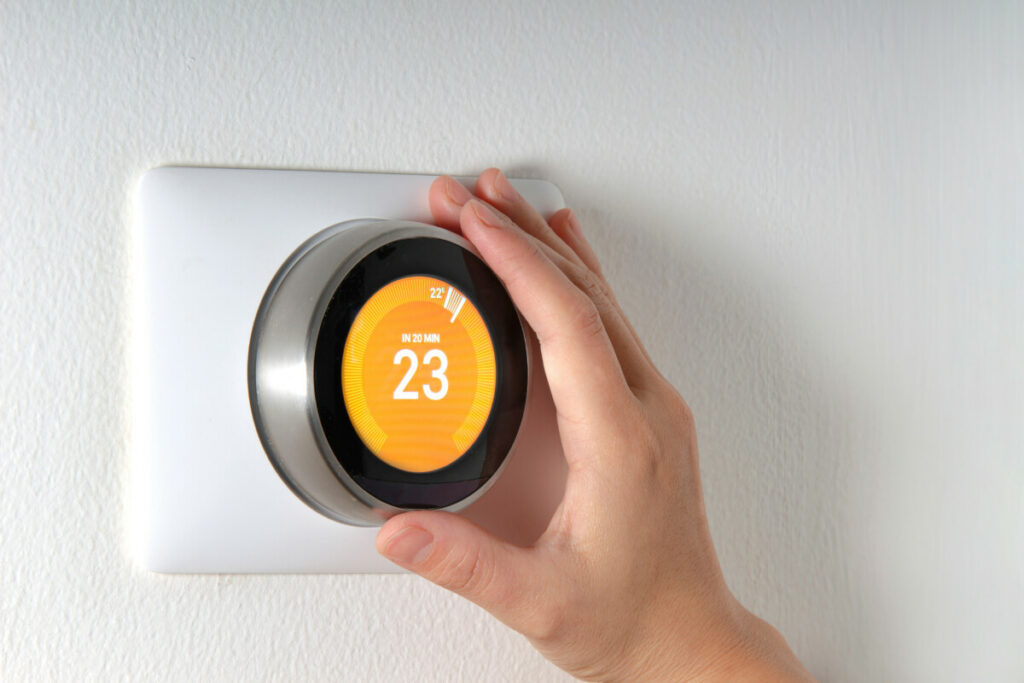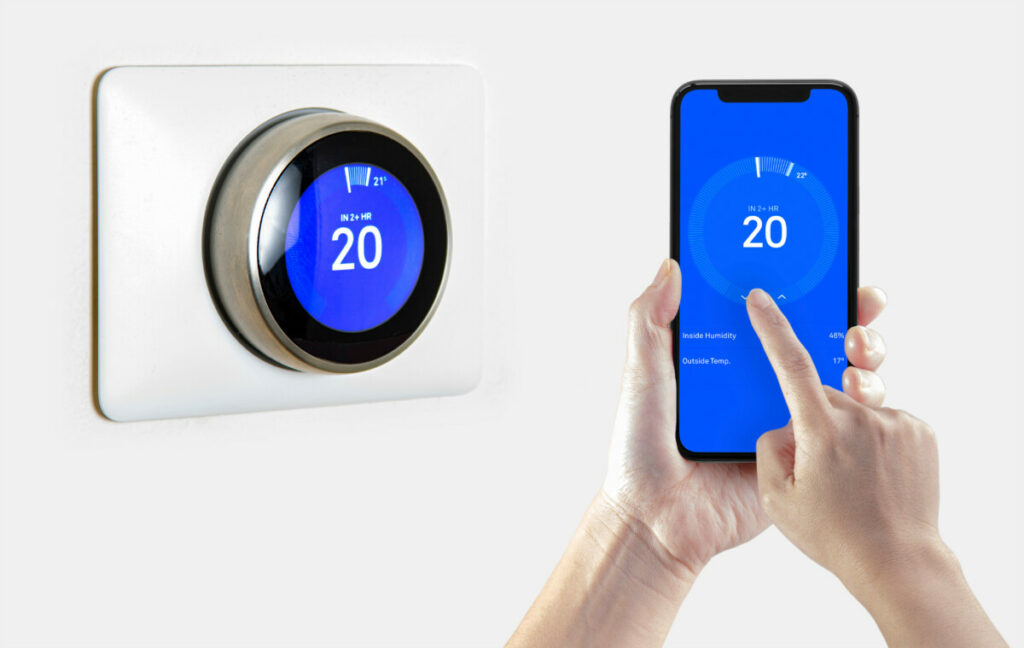- Making the Most of Your Smart Home: Common Use Cases - March 28, 2023
- Eco Mode at Night: Maximizing Nest’s Energy Savings - March 20, 2023
- Connecting & Controlling Smart Home Devices: A Guide - March 18, 2023
Disclosure: Links marked with * are Affiliate Links. As an Amazon Associate, I earn from qualifying purchases if you decide to make a purchase through these links – at no cost for you!

While they have been on the market for over a decade now, you may have never heard of a smart thermostat. On the other hand, you may have seen them in a family member’s or friend’s home, or in a commercial on TV, but you are not quite sure what they are. So, what is a smart thermostat, and what are the reasons that you should be looking into buying one?
Smart thermostats are thermostats for a home that can connect to a Wifi signal. This connection allows a homeowner to adjust and regulate the thermostat using their phone. Smart thermostats can adjust temperatures via schedules and have sensors to detect empty rooms and seasonal temperature changes.
With many different features coming with new models of smart thermostats, there is something for everyone. From people looking to save money on their electric bill to people wanting to avoid the hassle of dealing with a traditional thermostat, a smart thermostat is quickly becoming a crucial part of any home. With that in mind, here are the answers to some common questions about smart thermostats, as well as a quick look at some of the best smart thermostats on the market today.
Guide to our favorite thermostats: Which Nest Thermostat Do I Need? Differences and Compatibility
Table of Contents
What are Smart Thermostats?
The first thing that we need to do is determine what a smart thermostat is. Most if not all of you know what a thermostat is. Either in your home or apartment, there is at least one tool attached to the wall that allows you to adjust the temperature within the room, turn on the air conditioning or heating, and set times when you want to turn the heating and cooling in the apartment on or off.
The main difference between a smart thermostat and one of the thermostats that you are likely more familiar with is one thing: connection.
While a traditional thermostat is wired into the different mechanisms behind the walls of your home to keep it at your desired temperature, you have to physically go up to wherever the thermostat is to change the temperature or change any of the settings.
With a smart thermostat, you do not need to do this. Every smart thermostat is able to connect to a home Wifi signal, thus making it “smart”.
Since a smart thermostat can connect to Wifi, it is able to communicate with other devices that also use this Wifi signal. These devices include smartphones and other mobile devices, as well as any computers using a wireless connection.
Many of the features that come along with these smart thermostats are possible because of this shared wireless connection. Other more specific features require additional sensors, which we will talk more about below.
Now that we have established what a smart thermostat is, you may be wondering what type of features you can expect it to have.

What Features do Smart Thermostats Have?
When you first hear about smart thermostats, you might be wondering why we need another type of thermostat. Even after learning that by using wireless connections, the thermostat has many more options, you might be wondering if these options and features are even worth it.
What we will do here is go through some of the most common features that come with a smart thermostat and help you to understand why a smart thermostat is an excellent investment.
Wireless Access
The main reason that people look into buying a smart thermostat is to get wireless access. This allows them to link their thermostat to their phone.
From their phone, they can adjust the temperature of the room up or down, turn on a fan, or adjust other settings. This wireless access is closely linked with the next item on this list.
Easy to Use
Close behind the wireless access provided by a smart thermostat in importance is the ease of use that it provides to a homeowner. If you have ever used a standard thermostat in the past, you know how difficult they are to use.
There are buttons that never seem to work, a dimly lit screen that is hard to read, confusing menus that need to be navigated through, and schedules that are difficult to set and change as needed.
Since smart thermostats are wirelessly linked to your phone, thermostat companies provide a mobile app that you can adjust the thermostat from. This means that the days of squinting at a tiny screen will be gone, as you can use a clear and specifically designed app to adjust the thermostat to your preferences.
These apps make it easy to set a specific schedule for your thermostat, and even allow you to adjust the thermostat when you are outside of your home.
Combined with wireless access, these apps make smart thermostats quite easy to use.
Activity Sensors
Another feature that is commonly found in smart thermostats is activity sensors. Activity sensors are sensors that are built into the thermostats that can detect motion around them.
Like those that are connected to room lights nowadays, when the sensors do not detect motion for a period of time, they will signal to the thermostat to make the proper adjustments.
These sensors can automatically turn your thermostat up or down depending on the season, when you leave your home, and set itself back to normal once people are in the home again.
If you have multiple smart thermostats in your home, say one on the ground floor and another upstairs, each one can also make adjustments based on your movement around your home.
For example, if everyone is upstairs sleeping, it can adjust to direct most of the effort towards keeping the upstairs area of your home at the desired temperature and won’t focus as much on the downstairs.
Energy Optimization
Another feature of smart thermostats that might help you decide whether to get one if you are on the fence about it is their ability to help your home better optimize its energy usage.
With a traditional thermostat, you will only adjust it once it becomes very obvious to you that the temperature is incorrect. This means that if you are asleep or forget to turn the temperature up or down before you leave your home on a trip, you may be in for a higher-than-expected energy bill.
For this reason, the energy optimization feature on a smart thermostat can have immediate payouts for you once it is installed.
After the EPA completed research, they found that by using an energy-conscious thermostat, households could save as much as 10% on their energy bills alone.
Smart thermostats can help you to avoid using an excess amount of energy by starting and shutting down your home’s heating and cooling more evenly.
Automatic Adjustments
Another thing that these smart thermostats can do is make automatic adjustments based on specific circumstances. Many of the smart thermostats on the market today are equipped with geofencing technology.
This means that a smart thermostat can detect when a phone that is linked to it is nearby. This allows it to detect when you and your phone leave the home, reduce energy expenditure, and start the system back up once it senses your phone nearby.
Behavior Learning and Tracking
Another feature in newer models of smart thermostats is software that tracks its user’s behavior and adjusts the temperature as needed.
For example, if you like your room to be a bit cooler right before bed and as you sleep, the thermostat will take note of that and will adjust the temperature at that same time each day. This means that you will be able to sleep comfortably but won’t be extremely cold when you leave your blankets in the morning.
Adjustment to Weather
A new feature that has come out in recent years is the ability for a smart thermostat to adjust itself based on the temperature outside your home.
By using a wireless connection, a smart thermostat is able to determine what the weather is as it changes hourly. It is also able to pull up weather forecasts and plan ahead on any adjustments it needs to make.

Do Smart Thermostats Save You Money?
With all of these different features that we explored above, it might seem like a smart thermostat should be installed in every home and apartment.
However, in reality, they are only found in a small number of homes around the US and have yet to become a household necessity. This might lead some people to question if any of these features are worth the money, or even if a smart thermostat will save you any money at all.
The short answer is yes, a smart thermostat will save you money. As we mentioned earlier, in studies that the EPA has done on homes with smart thermostats over the decade-long period of time that they have been out on the market, they have found that by using a smart thermostat, homeowners can expect to save 8% to 10% on their energy bills.
This percentage did not change depending on the size of the energy bill, meaning that homeowners in areas with more temperate climates could expect a reduction on their bill similar to the percentage for homes found in more extreme climates.
Another thing to consider is the amount of time that you spend worrying about your thermostat right now. How much are that time and effort worth to you?
In a survey by Consumer Reports, they asked people who had switched to using a smart thermostat several questions. 50% of those that responded reported the smart thermostat was easier to use than their old thermostat, with an additional 25% saying it was about the same as before.

Which Homes Can Use a Smart Thermostat?
While everyone can benefit from installing a smart thermostat in their home, those of you with a home that is a bit older might be wondering if a smart thermostat is compatible with your home. With that in mind, here are some things that you will need to check before running out and buying a smart thermostat for your home.
The first thing you will need to check is whether your home has a variable-speed air conditioner or a heating pump. These pieces of equipment are designed to run almost constantly and become more efficient over time.
This comes into conflict with one of a smart thermostat’s main features, which is to frequently turn your home’s heating and cooling on and off as needed.
If your home uses one of these systems, you will want to be more deliberate about how you program your smart thermostat to avoid wasting energy.
Another potential issue is if your home uses an older HVAC (Heating, ventilation, and air conditioning) system. Homes without a dedicated C-Wire will have to be more selective with what smart thermostats they choose.
Many smart thermostats require this C Wire in order to operate. This can be avoided to a certain extent, but it is much easier to install a smart thermostat in a home that has an available C Wire.
One final concern to keep an eye out for is if your home uses radiators to heat its rooms. Radiators built into a home’s baseboards generally will not work with a smart thermostat. This is due in part to the difference in voltages that they operate on.
While this is a more specific concern and is not applicable to everyone, it is always a good idea to do a bit of background research into your home before buying a smart thermostat.
Older equipment like radiators or HVAC systems may not work with every smart thermostat on the market. There are adapters and systems to get across these barriers, but they will add additional costs to the installation of a smart thermostat in your home.
Other than these situations outlined above, the heating and cooling systems of other homes should be able to be controlled by a smart thermostat worry-free.
Overall, smart thermostats are useful tools that many people think are worth buying and installing in your home.
Attention: When installing electronic equipment, please be sure to observe the manufacturer’s safety instructions. You have to take care of your own safety. The information on this site only helps you to learn.
Disclosure: This website is the property of Martin Lütkemeyer and is operated by Martin Lütkemeyer. Martin Lütkemeyer is a member of the Amazon Services LLC Affiliate Program, an affiliate advertising program designed to enable Web sites to earn advertising revenue through advertising and linking to Amazon.com. Links marked with * are affiliate links.
